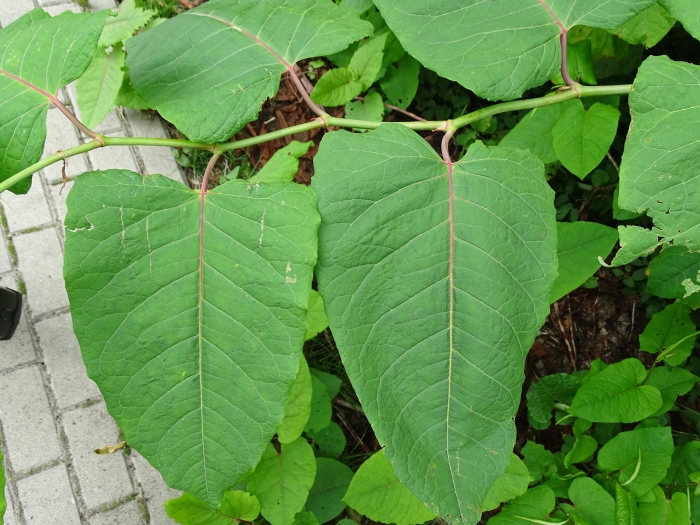Giant Knotweed
(Reynoutria sachalinensis)
Giant Knotweed (Reynoutria sachalinensis)
/
/

© Grzegorz Grzejszczak
CC BY-SA 4.0
Image By:
© Grzegorz Grzejszczak
Recorded By:
Copyright:
CC BY-SA 4.0
Copyright Notice:
Photo by: © Grzegorz Grzejszczak | License Type: CC BY-SA 4.0 | License URL: http://creativecommons.org/licenses/by-sa/4.0/ | Uploader: grzegorz_grzejszczak | Publisher: iNaturalist |

























Estimated Native Range
Summary
Reynoutria sachalinensis, commonly known as giant knotweed, is a herbaceous perennial native to volcanic valleys, riverbanks, and coastal areas in northern Japan and the Russian Far East. It can grow to an impressive height of 7-13 feet with a similar spread, and is characterized by its large, heart-shaped leaves that can reach up to 16 inches in length. The plant produces small, creamy-white flowers in dense, branched panicles during late summer and early autumn, which are not particularly showy but can add textural interest to the garden.
Giant knotweed is valued for its rapid growth and ability to stabilize soil, making it useful for erosion control. However, its aggressive nature and extensive rhizome system can lead to it becoming invasive outside its native range, so caution is advised. It thrives in a variety of soil types, provided they are moist and well-drained, and it prefers full sun to partial shade. In cultivation, it is often used in large-scale plantings where space allows, such as in restoration projects or as a screen. Due to its potential invasiveness, it is not recommended for small gardens or mixed borders.CC BY-SA 4.0
Giant knotweed is valued for its rapid growth and ability to stabilize soil, making it useful for erosion control. However, its aggressive nature and extensive rhizome system can lead to it becoming invasive outside its native range, so caution is advised. It thrives in a variety of soil types, provided they are moist and well-drained, and it prefers full sun to partial shade. In cultivation, it is often used in large-scale plantings where space allows, such as in restoration projects or as a screen. Due to its potential invasiveness, it is not recommended for small gardens or mixed borders.CC BY-SA 4.0
Plant Description
- Plant Type: Herb
- Height: 8-13 feet
- Width: 6-8 feet
- Growth Rate: Rapid
- Flower Color: White
- Flowering Season: Summer, Fall
- Leaf Retention: Deciduous
Growth Requirements
- Sun: Full Sun
- Water: Medium
- Drainage: Fast, Medium, Slow
Common Uses
Bank Stabilization, Erosion Control
Natural Habitat
Volcanic valleys, riverbanks, and coastal areas in northern Japan and the Russian Far East
Other Names
Common Names: Sakhalin Knotweed
Scientific Names: , Reynoutria sachalinensis, Fallopia sachalinensis, Pleuropterus sachalinensis, Polygonum sachalinense, Polygonum sachalinense, Polygonum sachalinense, Polygonum sachalinensis, Polygonum sachalinensis, Polygonum vivax
GBIF Accepted Name: